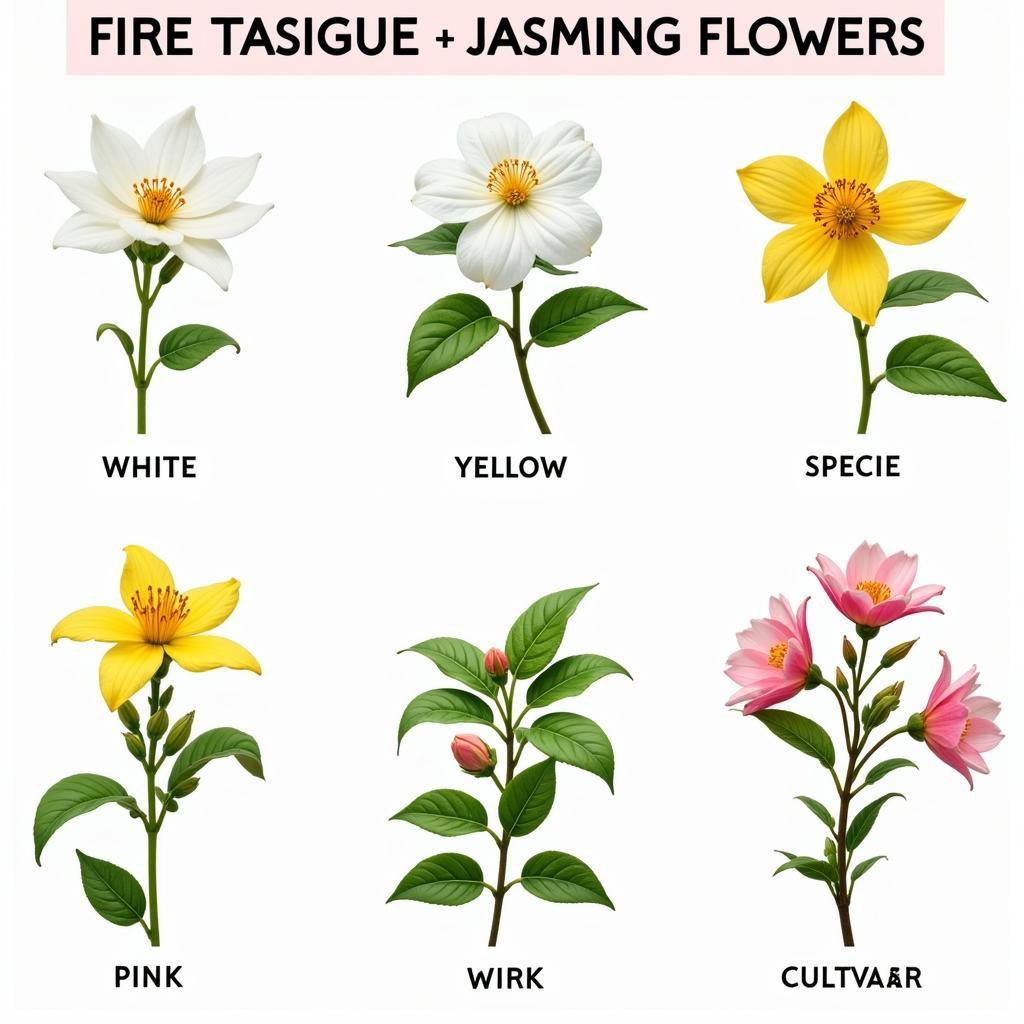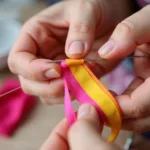What Color Is Jasmine? Most people envision a pristine white blossom, and they wouldn’t be wrong. However, the world of jasmine is more diverse than you might think. While white is the most common color, jasmine flowers can also come in shades of yellow, and even a delicate pink. This article delves into the fascinating world of jasmine colors, exploring the varieties, symbolism, and the factors that influence their beautiful hues.
Unveiling the Color Palette of Jasmine
The color of a jasmine flower largely depends on its species. The Jasminum officinale, or common jasmine, is renowned for its pure white, star-shaped flowers. This is the variety most often used in perfumes and teas, thanks to its potent, sweet fragrance. However, other species like the Jasminum nudiflorum, also known as winter jasmine, boast vibrant yellow blossoms that brighten up the winter landscape. There are also certain cultivars, like the ‘Grand Duke of Tuscany’, which exhibit a blush pink hue. This variety, with its double blooms, offers a unique twist on the classic jasmine aesthetic. Understanding the variety is key to knowing what color to expect. Would you like to know what color is a jasmine flower? This article will provide further insights.
 Jasmine Flower Color Variations
Jasmine Flower Color Variations
Why is Jasmine Usually White?
White is the predominant color in jasmine due to the pigments, or lack thereof, within the petals. White flowers generally lack pigments like anthocyanins, which create red, purple, and blue hues. Instead, the white color comes from the scattering of light by air spaces within the petal’s cells. This gives the flowers their pure, luminous appearance. This lack of pigmentation also allows the fragrance to be more pronounced, as the plant’s energy isn’t diverted to pigment production. This makes white jasmine particularly desirable for perfume and tea production.
The Significance of Yellow Jasmine
Yellow jasmine, while less common than its white counterpart, holds its own unique charm. The vibrant color often symbolizes friendship, joy, and optimism. Winter jasmine, with its bright yellow flowers blooming amidst the cold, is a welcome sight, promising the return of warmth and spring. The yellow hue is produced by carotenoid pigments, the same pigments that give carrots their orange color.
 Yellow Winter Jasmine Blooming in Winter
Yellow Winter Jasmine Blooming in Winter
Beyond White and Yellow: The Rare Pink Jasmine
Pink jasmine is a rarer find, and often comes in subtle, blush tones. These delicate hues add a touch of romance and elegance to the traditional jasmine aesthetic. The pink color arises from small amounts of anthocyanin pigments, which are also responsible for red and purple colors in flowers. Finding a pink jasmine cultivar can be a real treat for any flower enthusiast. Want to learn more about coloring other natural elements? Discover how do i color rice or how to cook colored rice. These resources might inspire you to explore a wider spectrum of natural colors.
The Impact of Environment on Jasmine Color
While genetics play the primary role in determining jasmine color, environmental factors can also influence the intensity and shade of the blooms. For example, soil pH can affect pigment production, with slightly acidic soils sometimes leading to more vibrant colors. Sunlight exposure also plays a role. Too much direct sunlight can cause fading, while too little can result in paler hues. Maintaining the optimal growing conditions will help your jasmine plants achieve their most vibrant color potential.
“Understanding the specific needs of each jasmine variety is crucial for achieving optimal color and fragrance,” says renowned horticulturist, Dr. Amelia Green. “Careful attention to soil, sunlight, and watering will ensure your jasmine plants thrive and display their most beautiful hues.”
Conclusion: A Spectrum of Beauty
So, what color is jasmine? The answer is a beautiful spectrum, ranging from the classic pristine white to sunny yellows and even delicate pinks. Each color holds its own charm and significance, adding to the allure of this beloved bloom. By understanding the different varieties and the factors that influence their color, you can appreciate the full beauty and diversity of the jasmine flower.
FAQ
- What is the most common color of jasmine? White is the most common color.
- What does yellow jasmine symbolize? Yellow jasmine symbolizes friendship, joy, and optimism.
- Can jasmine be pink? Yes, certain cultivars of jasmine can be a delicate pink.
- What affects the color intensity of jasmine? Factors like soil pH and sunlight exposure can influence the color intensity.
- Which type of jasmine is used in perfumes? Jasminum officinale (common jasmine) is commonly used in perfumes.
- What is the name of the yellow winter blooming jasmine? Jasminum nudiflorum is also known as winter jasmine.
- Where can I find more information about different jasmine varieties? Online botanical databases and gardening resources offer more in-depth information.
Do you have other questions?
Perhaps you’re wondering about the best time to plant jasmine, or how to prune it for optimal blooming. Maybe you’re interested in learning more about the cultural significance of jasmine in different parts of the world.
More resources available on Color Box Ha Noi
For further information on color and other related topics, please explore more articles on our website.
Need help choosing the perfect colors for your home or business? Contact us! Phone: 0373298888, Email: [email protected] or visit us at 86 Cau Giay, Hanoi. We have a 24/7 customer service team ready to assist you.

